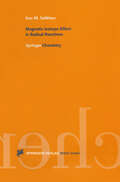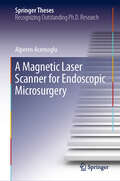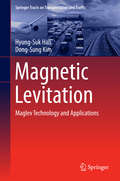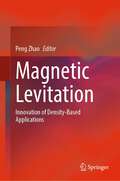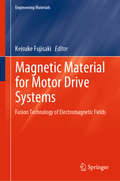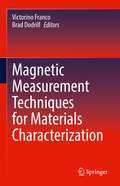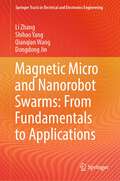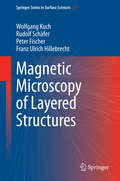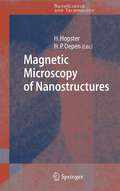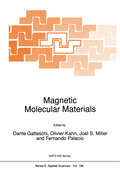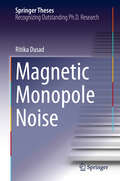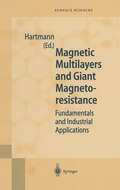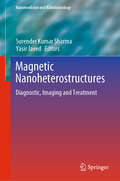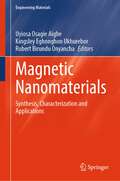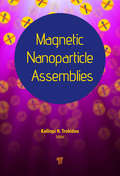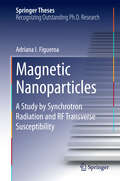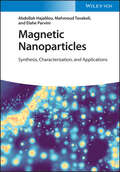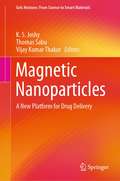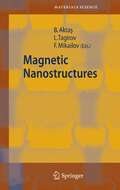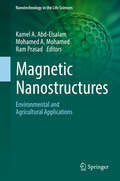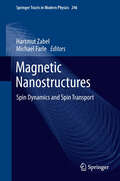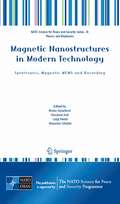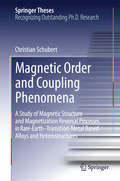- Table View
- List View
Magnetic Isotope Effect in Radical Reactions: An Introduction
by Kev M. SalikhovIn the last two decades it was demonstrated that, in addition to masses and charges, magnetic moments of nuclei are able to influence remarkably chemical reactions. This book presents the physical background (both theoretical and experimental) of the magnetic isotope effects in radical reactions in solutions. Special attention has been paid to the quantitative interpretation of the available experimental data. This book will be useful for physicists, chemists and biologists employing the isotope effect in their investigations as well as for those involved in isotope separation and isotope enrichment projects. Additionally, the magnetic isotope effect appears to be important in geochemistry and cosmochemistry. The book can be recommended for postgraduates and senior undergraduate students.
A Magnetic Laser Scanner for Endoscopic Microsurgery (Springer Theses)
by Alperen AcemogluThis book focuses on the design, development, and characterization of a compact magnetic laser scanner for microsurgical applications. In addition, it proposes a laser incision depth controller to be used in soft tissue microsurgeries.The use of laser scanners in soft tissue microsurgery results in high quality ablations with minimal thermal damage to surrounding tissue. However, current scanner technologies for microsurgery are limited to free-beam lasers, which require direct line-of-sight to the surgical site, from outside the patient. Developing compact laser micromanipulation systems is crucial to introducing laser-scanning capabilities in hard-to-reach surgical sites, e.g., vocal cords.In this book, the design and fabrication of a magnetically actuated endoscopic laser scanner have been shown, one that introduces high-speed laser scanning for high quality, non-contact tissue ablations in narrow workspaces. Static and dynamic characterization of the system, its teleoperation through a tablet device, and its control modelling for automated trajectory executions have been shown using a fabricated and assembled prototype. Following this, the book discusses how the laser position and velocity control capabilities of the scanner can be used to design a laser incision depth controller to assist surgeons during operations.
Magnetic Levitation: Maglev Technology and Applications (Springer Tracts on Transportation and Traffic #13)
by Hyung-Suk Han Dong-Sung KimThis book provides a comprehensive overview of magnetic levitation (Maglev) technologies, from fundamental principles through to the state-of-the-art, and describes applications both realised and under development. It includes a history of Maglev science and technology showing the various milestones in its advancement. The core concepts, operating principles and main challenges of Maglev applications attempted across various fields are introduced and discussed. The principle difficulties encountered when applying Maglev technology to different systems, namely air gap control and stabilization, are addressed in detail. The book describes how major advancements in linear motor and magnet technologies have enabled the development of the linear-motor-powered Maglev train, which has a high speed advantage over conventional wheeled trains and has the potential to reach speed levels achieved by aircraft. However, many expect that Maglev technology to be a green technology that is applied not only in rail transportation, but also in diverse other fields; to ensure clean transfer in LCD manufacturing, in ropeless high speed elevators, small capacity rail transportation, space vehicle launchers, missile testers, energy storage, and so on. These potential applications and their unique challenges and proposed technological solutions are introduced and discussed in depth. The book will provide readers from academia, research institutes and industry with insights on where and how to apply Maglev technology, and will serve as a guide to the realization of their Maglev applications.
Magnetic Levitation: Innovation of Density-Based Applications
by Peng ZhaoThis book introduces the MagLev testing method for density measurement and density-based applications of diamagnetic and low-magnetic objects using permanent magnets. The book surveys the most relevant papers on the theory and model of various MagLev methods that have become the foundation to elucidate the principles of MagLev and the conditions for stable levitation. A thorough summary of the improvements demonstrates the applications and potential of the MagLev method in many fields. This book is separated into 11 chapters to present MagLev testing method fully, including a review of the background of MagLev, theories and basic principles of the stable levitation of object, different dimensions of applications of MagLev in the fields of mechanical engineering, chemistry, and bioengineering, and sophisticated applications of manipulation and separation. This book would benefit the audience in the field of mechanical engineering, chemistry, materials science, and bioengineering, since magnetic levitation method has proved itself suitable for the density-based analysis and applications of materials of different scales. The analysis in this book will help the audience deeply understand the mechanism of magnetic levitation, and it can serve as an instruction for the magnetic levitation procedure, or guidebook for the magnetic levitation setup. With the viewpoints and thoughts about MagLev running through this book, this book may spark the audience’s interest towards magnetic levitation method, and enlighten them to further develop Maglev method.
Magnetic Material for Motor Drive Systems: Fusion Technology of Electromagnetic Fields (Engineering Materials)
by Keisuke FujisakiThis book focuses on how to use magnetic material usefully for electrical motor drive system, especially electrical vehicles and power electronics. The contents have been selected in such a way that engineers in other fields might find some of the ideas difficult to grasp, but they can easily acquire a general or basic understanding of related concepts if they acquire even a rudimentary understanding of the selected contents.The cutting-edge technologies of magnetism are also explained. From the fundamental theory of magnetism to material, equipment, and applications, readers can understand the underlying concepts. Therefore, a new electric vehicle from the point of view of magnetic materials or a new magnetic material from the point of a view of electric vehicles can be envisioned: that is, magnetic material for motor drive systems based on fusion technology of an electromagnetic field. Magnetic material alone does not make up an electric vehicle, of course. Other components such as mechanical structure material, semiconductors, fuel cells, and electrically conductive material are important, and they are difficult to achieve. However, magnetic material involves one of the most important key technologies, and there are high expectations for its use in the future. It will be the future standard for motor-drive system researchers and of magneticmaterial researchers as well. This book is a first step in that direction.
Magnetic Measurement Techniques for Materials Characterization
by Victorino Franco Brad DodrillThis book discusses the most commonly used techniques for characterizing magnetic material properties and their applications. It provides a comprehensive and easily digestible collection and review of magnetic measurement techniques. It also examines the underlying operating principles and techniques of magnetic measurements, and presents current examples where such measurements and properties are relevant. Given the pervasive nature of magnetic materials in everyday life, this book is a vital resource for both professionals and students wishing to deepen their understanding of the subject.
Magnetic Micro and Nanorobot Swarms: From Fundamentals to Applications (Springer Tracts in Electrical and Electronics Engineering)
by Li Zhang Shihao Yang Qianqian Wang Dongdong JinThis book is focused on the attractive emerging field of micro-/nanorobot swarms (microswarms). It introduces fundamental understandings of various microswarms, including pattern generation, transformation, locomotion, and imaging. This book also demonstrates applications of micro-/nanorobot swarms in different fields, such as biomedical, environmental, and electrical applications. The detailed theoretical analysis and experimental demonstrations in this book provide readers ranging from students to researchers with a realistic picture of progress achieved in the field of micro-/nanorobot swarms.
Magnetic Microhydrodynamics: An Emerging Research Field (Topics in Applied Physics #120)
by Bernard Doudin Michael Coey Andrejs CēbersThis open access book presents the most recent advances in the novel, interdisciplinary field of magnetic microhydrodynamics. This emerging area of advanced research combines magnetism with the knowledge of bioinspired local flow control to create novel concepts and technological solutions that could revolutionize the field of microfluidics. Edited and authored by world-recognized leaders in this field, this book covers how the action of magnetic forces on soft matter can result in a richness of possible static and dynamic behavior. The contributions featured in this book introduce timely examples of novel concepts (new fluids and control), processes at interfaces (local probes, electrochemistry), and applications of magnetic soft matter in cell biology, cargo transport, and energy. This book is of great interest to scientists from various backgrounds looking to explore, learn of recent developments, and take part in laying the foundations of an entirely new and dynamic field of research.
Magnetic Microscopy of Layered Structures (Springer Series in Surface Sciences #57)
by Wolfgang Kuch Rudolf Schäfer Peter Fischer Franz Ulrich HillebrechtThis book presents the important analytical technique of magnetic microscopy. This method is applied to analyze layered structures with high resolution. This book presents a number of layer-resolving magnetic imaging techniques that have evolved recently. Many exciting new developments in magnetism rely on the ability to independently control the magnetization in two or more magnetic layers in micro- or nanostructures. This in turn requires techniques with the appropriate spatial resolution and magnetic sensitivity. The book begins with an introductory overview, explains then the principles of the various techniques and gives guidance to their use. Selected examples demonstrate the specific strengths of each method. Thus the book is a valuable resource for all scientists and practitioners investigating and applying magnetic layered structures.
Magnetic Microscopy of Nanostructures (NanoScience and Technology)
by Herbert Hopster Hans Peter OepenA comprehensive collection of overview articles on novel microscopy methods for imaging magnetic structures on the nanoscale. Written by leading scientists in the field, the book covers synchrotron based methods, spin-polarized electron methods, and scanning probe techniques. It constitutes a valuable source of reference for graduate students and newcomers to the field.
Magnetic Molecular Materials (NATO Science Series E: #198)
by D. Gatteschi O. Kahn Joel S. Miller Fernando PalacioOne of the major challenges of science in the last few years of the second millennium is learning how to design materials which can fulfill specific tasks. Ambitious as it may be, the possibilities of success are not ne~li~ble provided that all the different expertises merge to overcome the limits of eXIsting disciplines and forming new paradigms science. The NATO Advanced Research Workshop on "Magnetic Molecular Materials" was organized with the above considerations in mind in order to determine which are the most appropriate synthetic strategies, experimental techniques of investigation, and theoretical models which are needed in order to develop new classes of magnetic materials which are based on molecules rather than on metallic or ionic lattices. Why molecules? The answer may be obvious: molecular chemistry in principle fine can tune the structures and the properties of complex aggregates, and nature already provides a large number of molecular aggregates which can perform the most disparate functions. The contributions collected in this book provide a rather complete view of the current research accomplishments of magnetic molecular materials. There are several different synthetic approaches which are followed ranging from purely organic to inorganic materials. Some encouraging successes have already been achieved, even if the critical temperatures below which magnetic order is observed still are in the range requiring liquid helium.
Magnetic Monopole Noise (Springer Theses)
by Ritika DusadThis thesis presents the first ever measurement of the noise emitted by magnetic monopoles and the development of an exquisitely sensitive magnetic-field-noise spectrometer based on a superconducting quantum interference device (SQUID) that enabled it. Magnetic monopoles are highly elusive elementary particles exhibiting quantized magnetic charge. The prospects for studying them brightened recently with the theoretical discovery that the thermally excited states in certain classes of magnetic insulators exhibit all the characteristics of magnetic monopoles. Furthermore, in 2018, it was predicted that the random motion of magnetic monopoles inside would generate a very specific kind of magnetization noise. In this thesis, the author describes a new experimental technique, so-called spin noise spectroscopy, and the subsequent discovery of virtually all of the predicted features of the magnetic noise expected from a dense fluid of magnetic monopoles in crystals of Dy2Ti2O7. Remarkably, because this magnetic monopole noise occurs in the frequency range below 20kHz, when amplified by the SQUID it is actually audible to humans.
Magnetic Multilayers and Giant Magnetoresistance: Fundamentals and Industrial Applications (Springer Series in Surface Sciences #37)
by H.A.M. van Berg R. Coehoorn M.A.M. Gijs P. Grünberg T. Rasing K. RöllThis unified overview of recent progress in a growing, multi-disciplinary field places special emphasis on the industrial applications of magnetic multilayered materials. The text describes a wide range of physical aspects, together with experimental and theoretical methods.
Magnetic Nanoheterostructures: Diagnostic, Imaging and Treatment (Nanomedicine and Nanotoxicology)
by Surender Kumar Sharma Yasir JavedThis book contains most updated information on synthesis of magnetic nanohybrids, their physio-chemical properties, and key biological applications. It highlights the complexity of nanoheterostructures, especially magnetic metal oxides, ferrites and doped magnetic nanomaterials, and discusses their potential applications in the early detection, imaging and treatment of cancer. It also covers the toxicity and risk assessment of multifunctional nanomaterials. Providing an overview of magnetic nanoheterostructures, it appeals to a wide audience, from beginners and graduate-level students to experts in academia and industry.
Magnetic Nanomaterials: Synthesis, Characterization and Applications (Engineering Materials)
by Uyiosa Osagie Aigbe Kingsley Eghonghon Ukhurebor Robert Birundu OnyanchaThis book explores some of the latest and recent advances in the synthesis, characterization and applications of magnetic nanomaterials. It starts with an overview of magnetic nanomaterials, followed by a list of their synthesis and characterization methods. The book shows the potential of magnetic materials in different applications, including theranostic nanomedicine, heavy metals detection, dyes sensing, solar cells, wastewater treatment, decontamination of soil, and detection and monitoring of toxic gases. Moreover, it explores their use as drug and gene delivery agents, their biosafety and bioregulation facets, tissue engineering applications, and their potential for combating pathogens
Magnetic Nanoparticle Assemblies
by Kalliopi N. TrohidouMagnetic nanoparticles with diameters in the range of a few nanometers are today at the cutting edge of modern technology and innovation because of their use in numerous applications ranging from engineering to biomedicine. A great deal of scientific interest has been focused on the functionalization of magnetic nanoparticle assemblies. The underst
Magnetic Nanoparticles: A Study by Synchrotron Radiation and RF Transverse Susceptibility (Springer Theses)
by Adriana I. FigueroaMagnetic nanoparticles (NPs) are finding their place in many modern technologies such as electronics (memory or spintronic devices) and medicine (contrast media, electromagnetic thermal therapy) to name just a few examples. The application of modern techniques based on synchrotron radiation, in particular X-ray spectroscopies, as well as an rf transverse susceptibility probe, built ad hoc, allowed the author to investigate several classes of magnetic NPs with diverse applications. For example, the interesting anisotropic properties of CoW and CoPt NPs revealed new magnetic behaviour and phases. Gold NPs prepared on a biological template from Sulfolobus acidocaldarius S-layer, were shown to possess intrinsic magnetism caused by the electron exchange with the sulfur atoms of the template. Silica and oleic acid coated magnetite NPs showed excellent human compatibility while preserving the bulk magnetic figures of merit. Both macroscopic and microscopic properties of all these NPs, hitherto unexplained, have been revealed for the first time.
Magnetic Nanoparticles: Synthesis, Characterization, and Applications
by Abdollah Hajalilou Mahmoud Tavakoli Elahe ParviniMagnetic Nanoparticles Learn how to make and use magnetic nanoparticles in energy research, electrical engineering, and medicine In Magnetic Nanoparticles: Synthesis, Characterization, and Applications, a team of distinguished engineers and chemists delivers an insightful overview of magnetic materials with a focus on nano-sized particles. The book reviews the foundational concepts of magnetism before moving on to the synthesis of various magnetic nanoparticles and the functionalization of nanoparticles that enables their use in specific applications. The authors also highlight characterization techniques and the characteristics of nanostructured magnetic materials, like superconducting quantum interference device (SQUID) magnetometry. Advanced applications of magnetic nanoparticles in energy research, engineering, and medicine are also discussed, and explicit derivations and explanations in non-technical language help readers from diverse backgrounds understand the concepts contained within. Readers will also find: A thorough introduction to magnetic materials, including the theory and fundamentals of magnetization In-depth explorations of the types and characteristics of soft and hard magnetic materials Comprehensive discussions of the synthesis of nanostructured magnetic materials, including the importance of various preparation methods Expansive treatments of the surface modification of magnetic nanoparticles, including the technical resources employed in the process Perfect for materials scientists, applied physicists, and measurement and control engineers, Magnetic Nanoparticles: Synthesis, Characterization, and Applications will also earn a place in the libraries of inorganic chemists.
Magnetic Nanoparticles: Synthesis, Characterization, and Applications
by Abdollah Hajalilou Mahmoud Tavakoli Elahe ParviniMagnetic Nanoparticles Learn how to make and use magnetic nanoparticles in energy research, electrical engineering, and medicine In Magnetic Nanoparticles: Synthesis, Characterization, and Applications, a team of distinguished engineers and chemists delivers an insightful overview of magnetic materials with a focus on nano-sized particles. The book reviews the foundational concepts of magnetism before moving on to the synthesis of various magnetic nanoparticles and the functionalization of nanoparticles that enables their use in specific applications. The authors also highlight characterization techniques and the characteristics of nanostructured magnetic materials, like superconducting quantum interference device (SQUID) magnetometry. Advanced applications of magnetic nanoparticles in energy research, engineering, and medicine are also discussed, and explicit derivations and explanations in non-technical language help readers from diverse backgrounds understand the concepts contained within. Readers will also find: A thorough introduction to magnetic materials, including the theory and fundamentals of magnetization In-depth explorations of the types and characteristics of soft and hard magnetic materials Comprehensive discussions of the synthesis of nanostructured magnetic materials, including the importance of various preparation methods Expansive treatments of the surface modification of magnetic nanoparticles, including the technical resources employed in the process Perfect for materials scientists, applied physicists, and measurement and control engineers, Magnetic Nanoparticles: Synthesis, Characterization, and Applications will also earn a place in the libraries of inorganic chemists.
Magnetic Nanoparticles: A New Platform for Drug Delivery (Gels Horizons: From Science to Smart Materials)
by K. S. Joshy Thomas Sabu Vijay Kumar ThakurThis volume covers current research in the usage of magnetic nanoparticles for drug delivery. It discusses synthesis methods, stabilizers used for surface coating on MNPs, and potential target ligands which can be used to ferry payloads to the targeted disease region. It also highlights the factors affecting delivery efficiency and toxicity, as well as the different routes of administration. The content also focus on the use of these carriers for gene therapy and to target brain tumors. This volume will be of interest to researchers working on drug discovery and delivery platforms.
Magnetic Nanostructures (Springer Series in Materials Science #94)
by Bekir Aktas Lenar Tagirov Faik MikailovThis volume addresses the exciting and rapidly developing topic of ultrahigh-density magnetic data storage. It is the most advanced book on magnetic nanostructures, basics and applications. It combines modern topics in nanomagnetism with issues relating to the fabrication and characterization of magnetic nanostructures. This book will be of interest to R and D scientists and it provides an accessible introduction to the essential issues.
Magnetic Nanostructures: Environmental and Agricultural Applications (Nanotechnology in the Life Sciences)
by Kamel A. Abd-Elsalam Mohamed A. Mohamed Ram PrasadRecently, magnetic nanostructures have gained a remarkable interest for basic research and applied studies. Because of their low cost and ease of manufacture and modification, they have great potential for agricultural and environmental applications. The use of magnetic nanostructures has been proven in a wide range of fields including catalysis, biotechnology, biomedicine, magnetic resonance imaging, agriculture, biosensors, and removal of environmental pollutants, among others. This book includes 16 chapters of collected knowledge, discoveries, and applications in agriculture, soil remediation, and water treatment. It describes the role of nano-agriculture with regard to food security and discusses environmental and agricultural protection concerns. It further offers potential applications of magnetic nanomaterials in the agriculture and food sectors, such as the development of sensors, environment monitoring for wastewater treatment and the remediation of contaminated soils. Increasing crop yield through the use of nanopesticides or nanofertilizers and biosecurity using sensors for detecting pathogens along the entire food chain are discussed as well. This book also brings together various sources of expertise on different aspects magnetic nanostructure application in the agri-food sector and environment remediation. Magnetic nanostructures also have great potential in biotechnological processes, as they can be utilized as a carrier for enzymes during different biocatalytic transformations. Novel magnetic nanomaterials can be used for detection and separation of pesticides from environmental and biological samples. The excellent adsorption capacity of the modified magnetic nanoadsorbents together with other advantages such as reusability, easy separation, environmentally friendly composition, and freedom of interferences of alkaline earth metal ions make them suitable adsorbents for removal of heavy metal ions from environmental and industrial wastes. One of the most important environmental applications of magnetic nanostructures has been in the treatment of water, whether in the remediation of groundwater or through the magnetic separation and/or sensing of contaminants present in various aqueous systems. The integrated combination of these 16 chapters, written by experts with considerable experience in their area of research, provides a comprehensive overview on the synthesis, characterization, application, environmental processing, and agriculture of engineered magnetic nanostructures. Its comprehensive coverage discusses how nanostructure materials interact in plants as well as their potential and useful applications.
Magnetic Nanostructures: Spin Dynamics and Spin Transport (Springer Tracts in Modern Physics #246)
by Hartmut Zabel Michael FarleNanomagnetism and spintronics is a rapidly expanding and increasingly important field of research with many applications already on the market and many more to be expected in the near future. This field started in the mid-1980s with the discovery of the GMR effect, recently awarded with the Nobel prize to Albert Fert and Peter Grünberg. The present volume covers the most important and most timely aspects of magnetic heterostructures, including spin torque effects, spin injection, spin transport, spin fluctuations, proximity effects, and electrical control of spin valves. The chapters are written by internationally recognized experts in their respective fields and provide an overview of the latest status.
Magnetic Nanostructures in Modern Technology: Spintronics, Magnetic MEMS and Recording (NATO Science for Peace and Security Series B: Physics and Biophysics)
by Bruno Azzerboni Giovanni Asti Luigi Pareti Massimo GhidiniIn this book, a team of outstanding scientists in the field of modern magnetic nanotechnologies illustrates the state-of-the-art in several areas of advanced magneto-electronic devices, magnetic micro-electromechanical systems and high density information storage technologies. Providing a unique source of information for the young physicist, chemist or engineer, the book also serves as a crucial reference for the expert scientist and the teacher of advanced university courses.
Magnetic Order and Coupling Phenomena: A Study of Magnetic Structure and Magnetization Reversal Processes in Rare-Earth-Transition-Metal Based Alloys and Heterostructures (Springer Theses)
by Christian SchubertThis thesis presents recent developments in magnetic coupling phenomena of ferrimagnetic rare-earth transition-metal Tb-Fe alloys and coupled systems consisting of ferri-/ferromagnetic heterostructures. Taking advantage of the tunability of the exchange coupling between ferrimagnetic and ferromagnetic layers by means of stoichiometry of the Tb-Fe layer, the variable number of repetitions in the Co/Pt multilayer as well as the thickness of an interlayer spacer, it is demonstrated that large perpendicular unidirectional anisotropy can be induced at room temperature. This robust perpendicular exchange bias at room temperature opens up a path towards applications in spintronics.
